#which instance of 'view post' will be a funny cat meme or a post about pretty colors
Explore tagged Tumblr posts
Text
bro tumblr's filter system is ass. I'm filtering out "eow" for echoes of wisdom to avoid spoilers until I can afford the game myself (both in tags and in the content of the post, because SO many people don't tag their shit right) and it's also blocking every post that contains "meow." on tumblr. on the fuckin poor little meow meow website
#i also tag hades for the same exact reason (for hades ii)#and tumblr hides every post containing “shades.” as in lampshades or shades of color#my dash is like russian roulette#which instance of 'view post' will be a funny cat meme or a post about pretty colors#and which will take all the joy out of the games i want to play
3 notes
·
View notes
Text
Get to know me tag!
I was tagged by @hannahs-creations in the original post!!! Thank you, Hannah! sorry im a bit late with it haha
Rules: Answer the questions and tag a few people!
I got a bit long-winded on these answers, so I’ll put them behind a readmore!
1. What made you decide to start writing or arting (assuming you write or do art)?
I can’t say I ever consciously decided to start writing - I’ve just always loved reading, and when I first got a school assignment for a creative story, I decided I never wanted to stop!
In terms of art, though, it was sparked by a similar thing: the Dragonology book. My first story was about a dragon in there, and part of that assignment was to make illustrations to accompany it, and I decided I needed to learn how to draw dragons. From there, I just fell in love with making a blank page into something I could look at and enjoy, and I’ve been drawing ever since!
2. What do you like to do more: photo editing or video editing?
Oh, this is a hard one... Video editing is fun for me, especially because, when I make videos, I tend to do speedpaints with commentary, and cutting my ramblings down to a manageable size is so satisfying. On the other hand, I like taking fairly mundane pictures and making them magical...
I’d say, for satisfaction levels, video editing wins. For the actual process, I think photo editing is my favorite!
3. Which do you prefer: YouTube or TikTok?
YouTube, 100%. The only TikToks I’ve ever seen have been sent to me by friends, and I don’t particularly like short videos like that? If it were Vine, though, Vine would win ;aslkdjf
4. How many books have you read in the last 5 years?
A lot, LOL
My favorite have been Six of Crows, The Stormlight Archive, Red rising, and The Fallen Empire!
5. Do you tend to post more cheery/cutesy things, silly things or more serious things to your blog?
I think silly things are the most common? I like to meme with my WIPs, since I just. love meme culture. And I like making jokes about things - it’s a quick and easy way to get myself to smile!
6. How long have you been on Tumblr? Just ramble for a minute about some changes you’ve noticed about the site.
I made my first Tumblr blog in 2013, and I kept that one up until about April of last year, I think, before I decided to remake.
The biggest change I’ve seen is the shift from sharing things to consuming things, in terms of like, reblog to like ratios and whatnot. Also, the amount of discourse has stayed about the same, but it’s changed in subject for the most part. But fandom discourse is still pretty much the same, just with different shows, now.
Also, reaction gifs have faded out of use pretty heavily since I started. At least, in the areas I’ve been in.
7. If the staff of tumblr came up to you, genuinely wanting advice on how to improve the site, what advice/request(s) would you give them?
I would tell them to rename likes into bookmarks. Also, lift the nsfw ban, and make it so that in order for 18+ blogs to be viewed, the user has to be 18+. Yes, people lie about their age, but so many sex workers lost their audiences and sources of income because of it, and it legitimately threw away a third of the userbase in one hit.
Also, no matter the pressures from other social sites, don’t make this site less anonymous. It’s one of the beauties of Tumblr - I’m never going to have a boss find my blog and know for sure that it’s me.
8. What was the most challenging thing about starting your favorite hobby? How did you get past it, if you ever did?
Well, at the time I started drawing, the biggest obstacle was finding a way to learn. The art classes in school were never trying to teach us how to draw something, just showing us that we could. I ended up getting “How to draw manga” books and looking up stuff on YouTube.
9. What do you think other people think of when they think of you? For instance, with me, most people think about either tomatoes, chinchillas or black cats, depending on the person and how long they’ve known me.
Well, I hope they think of my jokes, first of all a;lskdjf;aslkdfj
But in terms of like, objects or animals? Sketchbooks, pride flags, and dinosaurs.
10. If every animal except one specific species went extinct but you got to pick which one didn’t go extinct, which species would you pick?
Hmmmmmmm... probably Komodo Dragons. I really like big lizards :)
11. What do YOU feel makes the world go round?
Laughter! Or, really, anything that makes people smile!
12. What would you say to a person if you heard them talking shit about your best friend?
This has actually happened before, and they were saying it to my face without knowing we were best friends. I sat there, nodded along, and when they were done, just said “You know they’ve been my best friend for like, 7 years, right?”
They went so pale it was kind of funny.
13. What is the nicest thing anyone has ever said to you that has stuck with you?
This was more something they did, but when I was going through a nasty friend break up, I texted them, and within 5 minutes they were at my house, texting that person furiously, and letting me cry on them, even though they’re not a very emotional person themself ;-; I felt so loved in that moment, you have no idea.
14. What was the greatest piece of life advice you’ve ever gotten?
You have the rest of your life to wake up and decide who you’re going to be that day, and you should never feel bad about changing who that is from one day to the next.
It was said in the context of me realizing that I wasn’t genderfluid, I was transmasc, and my ongoing crisis over whether I’m fully a guy, or if I’m a bit more fluid than that. It’s helped me a lot with accepting that I might not have all the answers right now, and I don’t need all the answers all the time.
15. What one or two aspects of your childhood personality would you bring back to your current personality if you could?
Honestly? My willingness to just make things, and not care about how they turned out. I made so much art that I cringe at now, but I was learning, and that’s all that matters, really.
--
Okay, this was long, but I’m going to tag: @nothingisliteral, @violetcancerian, and @morgan-s-writes! Apologies if you’ve been tagged before, and as always, no pressure, and if you want to hop in, feel free to say I tagged you!!
1 note
·
View note
Text
Tumblr: Blog or Social Networking Site?
What are my thoughts about Tumblr?
I never dive deeply into this platform, though it is recently needed to be use for my Digital Communities unit. Now, the question is, what is Tumblr? If you look at the About page in Tumblr, they define Tumblr as our canvas where we are allowed to post text, photos, GIFs, videos, live videos, audio and anything else.
youtube
I myself have followed some users with different contents that I like such as arts, photography and celebrities. As I scroll through the dashboard, I see tons of different content formats – memes, videos, short and long texts. It reminds me of Twitter. Besides posting contents, I am able to share or ‘reblog’ other user’s content, it will appear in my profile and letting my followers see it, just like Twitter where we can retweet and let others see what we have shared. But in Twitter, the characters we typed are only limited to 240 characters, unlike Tumblr as we can write one whole essay in one post – which reminds me of Facebook. Though, Facebook is used more like a private social site for me as the friends I have there are family members and the posts I upload there would be more of my private life. The way I see Tumblr is just like what their About page said. I can be myself by sharing creative contents like photos that I think can inspire others. What is even more awesome about this platform is that I can customize the appearance of my profile but most social media sites has limited design flexibility except for changing our profile picture and cover photo. The whole customising the profile thing now reminds me of the old traditional Blogspot. So is it a blogging platform or a social networking site?
Is Tumblr a Blog?
My answer is yes. What is a blog? A blog can be an online journal of information website showing posts in the reverse chronological order with the latest post appears on top of the old ones (Skrba, 2019). It is a platform where views on a particular subject shared by the a single or group of writers. Traditional blogging usually was just a lot of writing and some photos in it. Users can write in Tumblr but make it more highly visual and putting photos, GIFs, memes and videos in their post. With the attractive feature Tumblr offers, a creative teams who wants a strong emphasise on their brand (if they do have one) and make their ‘blog’ look presentable, they can create a specific designs and details on their profile, either by the pre-existing theme or custom built. Users who used Tumblr as their blog can also engage with their audience as the readers can comment on their posts. If I use as a blog, I will not worry about reaching more readers as Tumblr has the reblog feature and hashtags!
Is Tumblr a Social Networking Site?
My answer is also yes. Social media is the collective of online communications channels dedicated to community-based input, interaction, content-sharing and collaboration (Rouse 2010). With Tumblr, people can connect globally and the best way to find people with the same interest as yours is to use the hashtags or just simply search in Tumblr. Users can post random contents every day for no purpose at all but just to simply share it with their followers. For instance, one day you took a video of your cat and thought that it is funny. You post it. The next day, you went out eating a delicious burger then took photos of it and share it. Your followers can like, comment and even reblog it! And you can do the same thing on your friend’s post that you followed on Tumblr.
In conclusion, Tumblr can be both a blogging platform and a social network. You choose. It really depends on what purpose you are using it for.

List of References:
Tumblr, 2007, Tumblr is where your interests connect you with your people, Tumblr, viewed on 13 October 2019, https://www.tumblr.com/about>.
Rouse, M 2019, Social media, TechTarget, viewed on 13 October 2019, https://whatis.techtarget.com/definition/social-media.
1 note
·
View note
Text
what memes had to do to us: breakdown for the meme-illiterate
What is a meme?
We talk about them all the time, but does anyone actually know how to define a meme? The most common form of meme is the image macro (pictures that get passed around with edited text/captions on them). But what about reaction gifs, planking/dabbing, Photoshop memes, Twitter hashtags, etc.? The image macro is only one kind of meme, though it’s the most archetypal kind of meme there is. How would one define “meme” in a way that encompasses all of these?
Time to dive into meme theory.
I’ll be basing this first part on a paper called “The Anonymity of a Murmur: Internet (and Other) Memes” by Simon J. Evnine. According to Evnine, a meme is a set of norms (Evnine 308). Or, more specifically:
Memeₒₙₜ: A meme is an abstract artefact made out of norms.
Meme𝒸ₒₙ: M is a meme if and only if M is made, as part of memographic practice, out of norms for producing things as parts of that memographic practice. (Evnine 315)
Where memeₒₙₜ = meme (ontological) and meme𝒸ₒₙ = meme (conceptual).
The ontological is just a more general definition answering what kind of category a meme falls under, while the conceptual specifies the exact thing within that category. For example: What is a teenager? Teenagerₒₙₜ = A person. Teenager𝒸ₒₙ = A person from the ages of 13-19 (Evnine 304).
Now...Unless you’ve read the paper, chances are that means next to nothing to you. Let’s break it down, starting with the ontological definition.
By "artefact", Evnine is referring to the result of someone imposing a concept onto some sort of matter in an intentional act of creation (Evnine 314). Basically, if you take matter and have a specific concept of what you want to make out of it, then go and intentionally create that thing out of that matter, you have an artefact. The meme is an “abstract” artefect because the "matter" it is made of is a set of norms—aka, it is made out of something that is not real.
How is a meme made out of “norms”? Well, take for example the distracted boyfriend meme, one example of the image macro. For the meme-illiterate, an example meme:

(Source x)
The “norms” of the distracted boyfriend meme is to use this picture, place text over the three figures, and have the relationship between the 3 labelled figures be that the boyfriend is distracted by/appears to prefer the girl in red over the girl in blue, who is presumably the girlfriend.
Now for the conceptual definition.
Meme𝒸ₒₙ: M is a meme if and only if M is made, as part of memographic practice, out of norms for producing things as parts of that memographic practice.
“Memographic practice” is kind of like the "meta-level" activity around a meme (Evnine 305). It is the process of sharing it, recreating it, riffing upon it, transforming it, etc.
Here are some examples of the distracted boyfriend meme that participate in memographic practice, which I found just by searching “distracted boyfriend meme” on Tumblr:
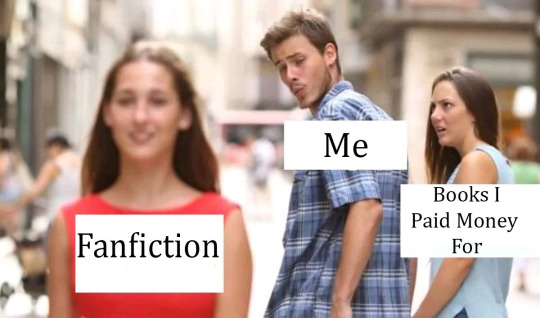
(Source x)
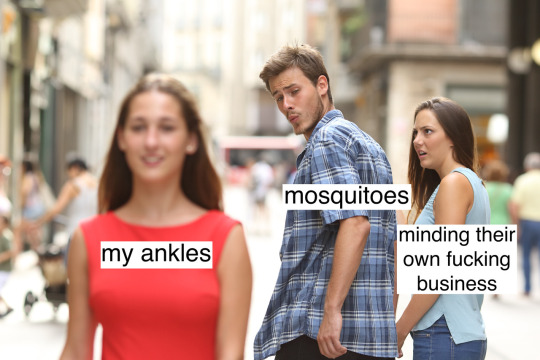
(Source x)
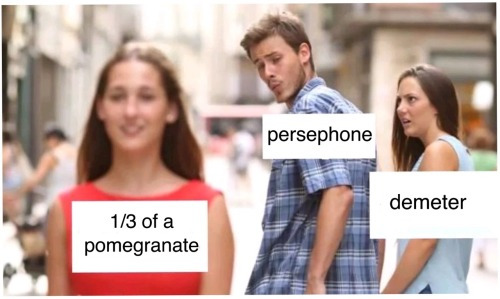
(Source x)
So basically, a meme is something that someone intentionally makes by imposing the concept of a "meme" onto a set of norms that were already pre-defined by memographic practice for the purpose of continuing memographic practice. Continuing the tradition, so to speak.
What about the first instance of a meme? When/how does a meme actually become a meme? Evnine has an answer for that, too. The first instance of a meme, i.e. the first time someone used the distracted boyfriend picture before there was memographic practice surrounding it to establish it as a meme, is part of a more general instance of meme that the Evnine calls MEME (Evnine 313).
MEME is just a meme𝒸𝒸 that results from the overall general existence of memographic practice, where meme𝒸𝒸 = meme common contents (a specific kind of meme, like the distracted boyfriend meme), and memeᵢ = one instance of a meme𝒸𝒸 (the example meme that I showed above).
So MEME covers initial instances of different kinds of meme𝒸𝒸 by being an overall meme𝒸𝒸 where its norms is the existence of memographic practice in general.
A diagram I made to illustrate this concept:
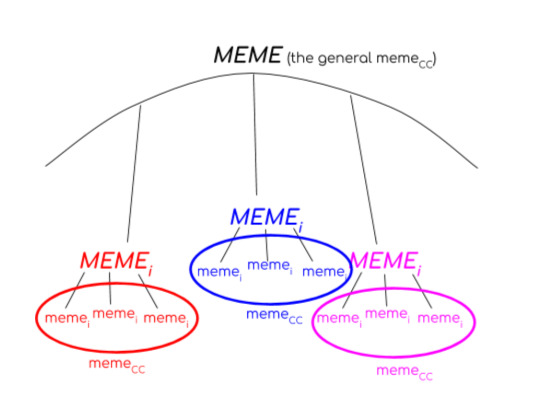
Additionally, a memeᵢ need not comply with all the norms in meme𝒸𝒸 (Evnine 317). For example, other photos of the same people in the original distracted boyfriend picture can be used, or a completely different picture could be substituted in if the relationship and positioning of the figures in that picture are recognizably similar to that of the original picture. Sometimes it isn’t text that is put on the figures, but the heads of characters from someone’s favorite show.
Some more examples:
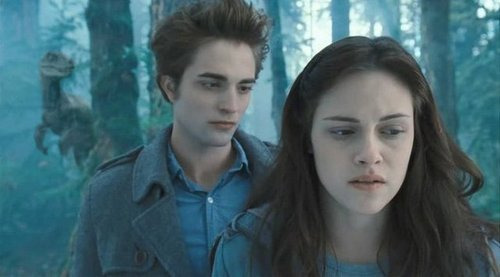
(Source x)
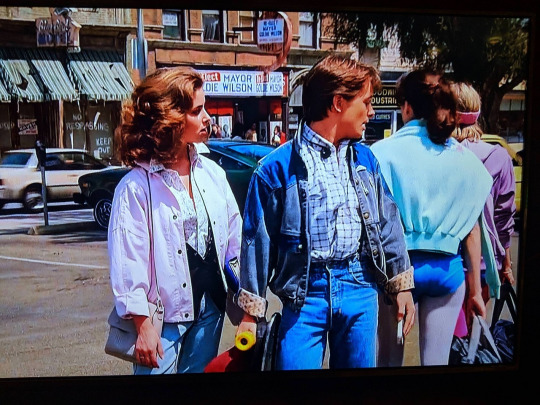
(Source x)
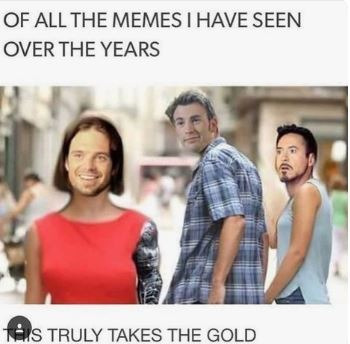
(Source x)
The point is, not all of the norms must be followed—just enough for it to be recognizably part of that meme𝒸𝒸 tradition. Thus, the norms within meme𝒸𝒸 may change/transform over time (Evnine 318).
So that’s what a meme is. Or at least, one conception of what a meme could be. What about memes in the wild? How do they function, what is their appeal?
-
How memes work
What’s unique about memes, then, isn’t that they’re participatory, or that they remix visuals and stock figures. What makes a meme a meme instead of a cartoon, a joke, or a fad is...a meme is an atom of internet culture...Creating, sharing, or laughing at a meme is staking a claim to being an insider: I am a member of internet culture it says, and if you don’t get this, then you aren’t (McCulloch, location 3668)
The above quote is from Gretchen McCulloch’s Because Internet: Understanding the New Rules of Language (which, by the way, I highly recommend.)
The in-jokes, the drawing of boundaries between those who “get it” and those who don’t, the group-bonding—that, is essentially, the heart of memes.
According to McCulloch, the internet is a “third place”:
The first place is home, the second place is work, but people also need a third place to socialize that’s neither home nor work, like a coffeeshop (McCulloch, location 3161)
This makes the internet a major site for linguistic change and innovation. It’s a place where people who may not have had pre-existing strong ties come together and socialize or exchange ideas. This aspect of the internet is also what allows the meme to thrive: ideas that catch move fast, and they spread further than they would have if they were otherwise confined in tightly-knit groups.
However, despite the fact that the internet functions on a network of (mainly) loose connections (I’m not saying that internet friends aren’t real friends—I’m simply referring to the fact that you probably follow more people and have more mutuals than you have internet friends), memes gain popularity because they create a sense of community.
Popular posts tended to strike a balance between somewhat obscure but not too cryptic—in-jokes and references that appealed strongly to a distinct subset of people (McCulloch, location 3292)
But what makes a popular post a meme? After all, it’s not as though any post that reaches a certain number of likes, reblogs, replies, retweets, upvotes, etc. automatically becomes a meme. Well, according to McCulloch:
A meme in the internet sense isn’t just something popular, a video or image or phrase that goes viral. It’s something that’s remade and recombined, spreading as an atom of internet culture” (McCulloch, location 3431)
In this sense, McCulloch’s idea of a meme aligns with Evnine’s. What makes a meme a meme is the existence of memographic practice surrounding the meme.
What was unique about the memes that took off was not the in-jokes, but the scale: in a world where in-jokes happen all the time and distribution costs are zero, a few of them can get really big because their in-groups are actually very large, like “people who agree that this particular cat looks very grumpy,” or “people who saw the previous very popular in-joke.” (McCulloch, location 3537)
“People who saw the previous very popular in-joke” is key. A lot of memes have a kind of absurd, incomprehensible humor to them. Why are they funny? No one knows. You can talk about dada-ism (or e-dada, like this Tumblr post suggests) and the state of the world but really, the humor behind the most popular memes are self-referential. They’re funny only because you get the reference, even if the reference itself doesn’t make sense.
-
Aesthetique™
Now that we have a working definition for what memes are and how they work, I would like to talk about what memes do. The affective qualities of the meme. Or, the aesthetic.
To explicate this, I will be using, of course, loss.jpg and Lucky Luciano (aka “you know I had to do it to em” guy).
Since this is written for the meme-illiterate, I'll be using copious examples of memographic practice in an attempt to illustrate the way memes overall affect us.
Let’s start with loss.jpg.
Loss.jpg starts with this comic, drawn by Ctrl+Alt+Del:
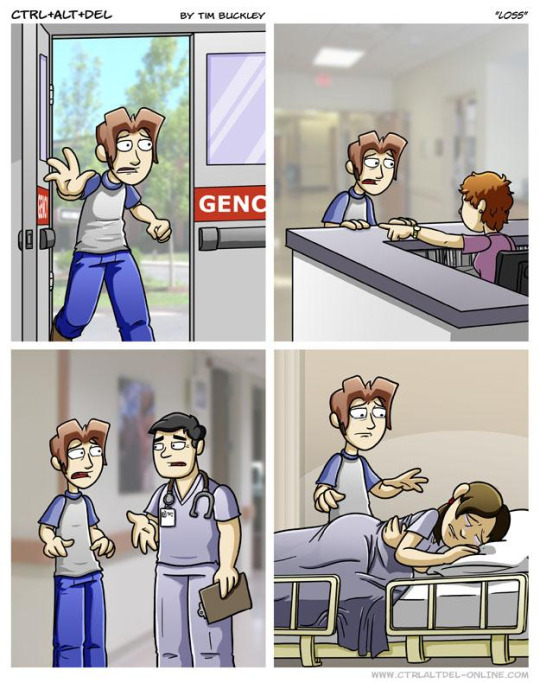
(Source x)
According to the KnowYourMeme page, the meme started out as “mockery” of the strip, generating countless parodies across the web. Though, at this point, I’d argue that loss has become so ubiquitous that even if it started out as mockery, it’s looped right back around to a kind of awe.
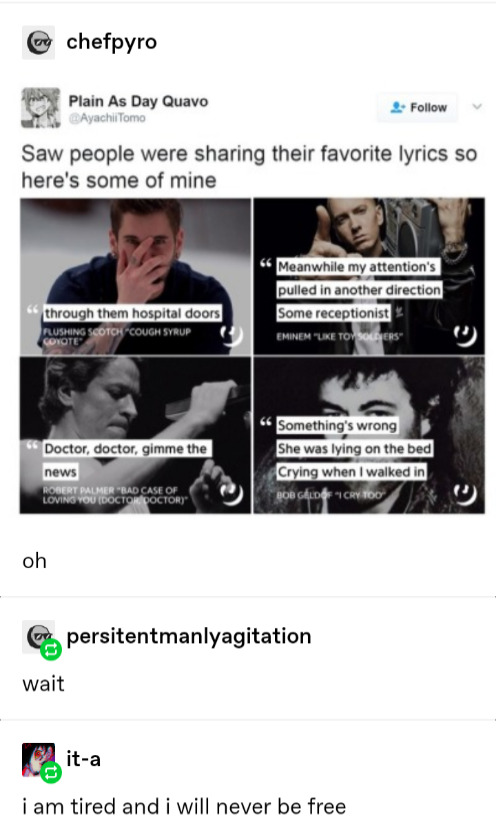
(Source x)
Most notable, however, is the fact that “norms” that make up loss have expanded and transformed to include minimalist portrayals of the comic.
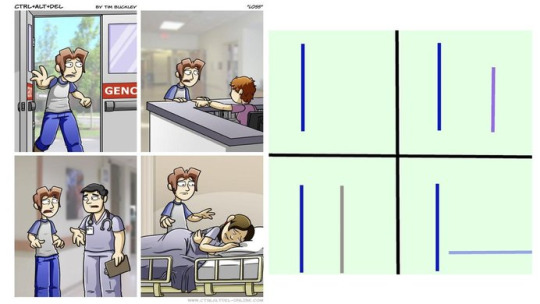
(Source: the KnowYourMeme page)
Some examples:
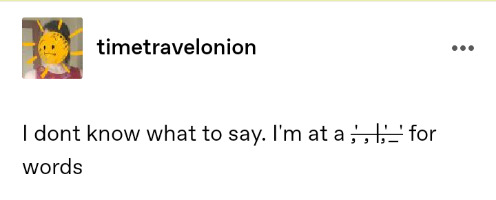
(Source x)
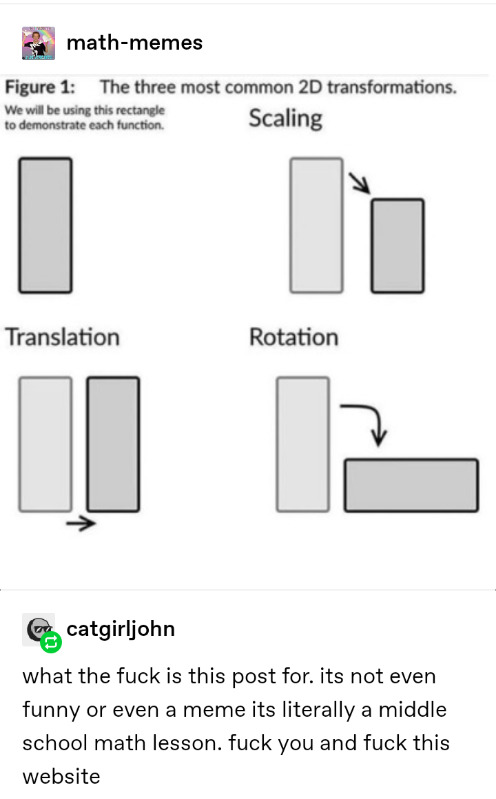
(Source x)
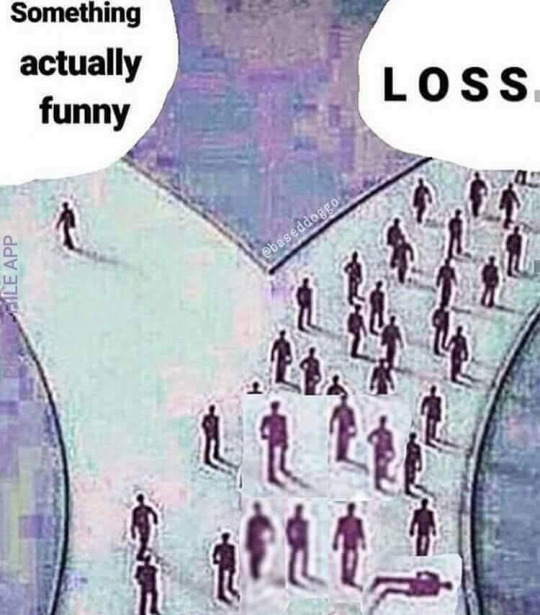
(Source x)
Lucky Luciano started out on Twitter, in a post that is no longer available to the public. Of course, the internet being what it is, it has been preserved for our viewing pleasure:

(Source: the KnowYourMeme page)
KnowYourMeme classifies this meme as type “Character, Photoshop”. The common norms of using this meme is to take a picture that someone else posted, and then repost it while hiding Lucky Luciano somewhere in the photo, “Where’s Waldo?” style. The meme became so popular that several blogs dedicated to documenting and furthering its memographic practice were created (wherethefuckishe, where-the-fuck-is-he and locate-lucky-luciano are the ones I’m aware of).

(Source x)

(Source x)

(Source x)
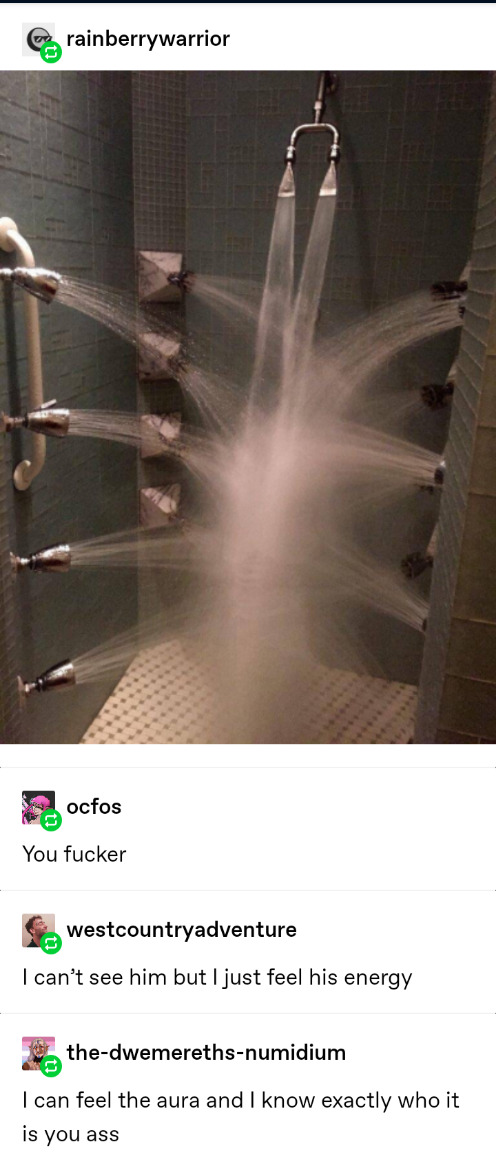
(Source x)
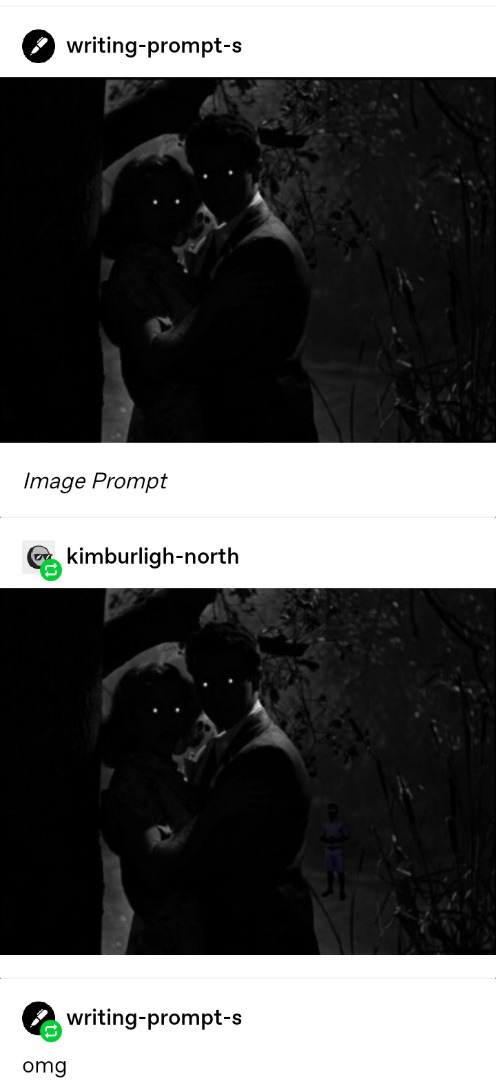
(Source x)
And my personal favorite:
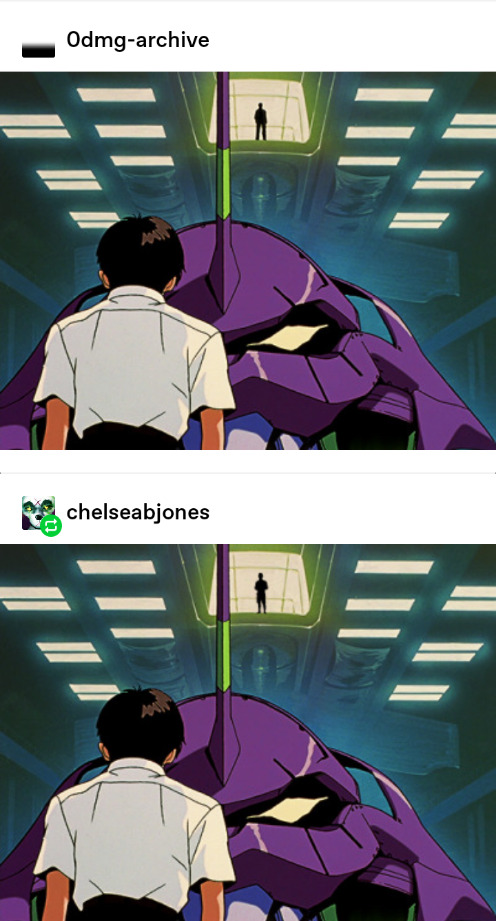
(Source x)
And just for fun, here’s a combo meme:
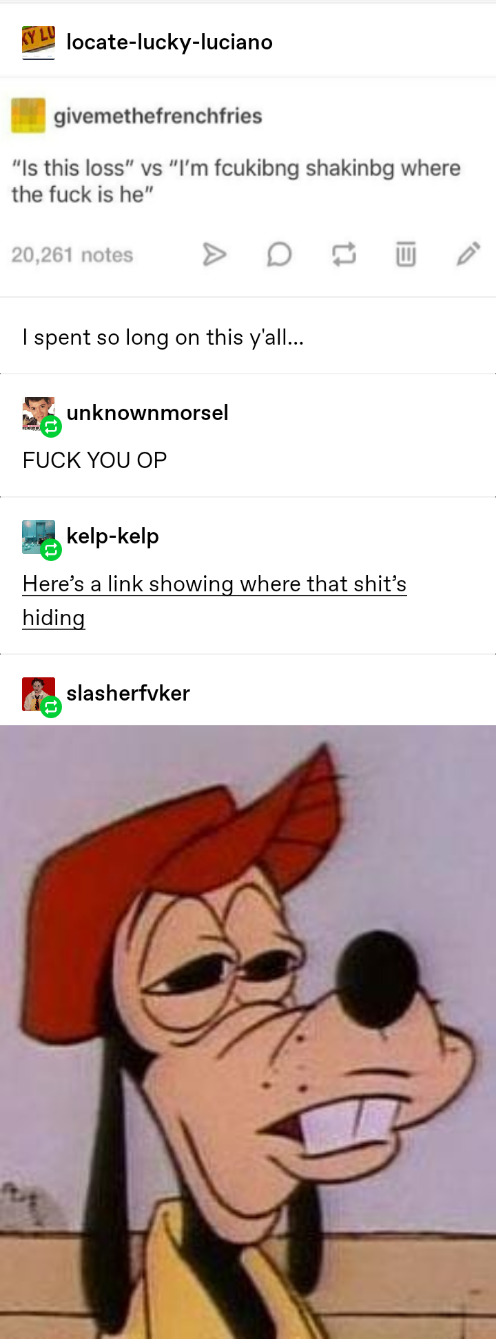
(Source x)
For those who don’t get that last one, the icon was edited to have both Lucky Luciano and loss.jpg:
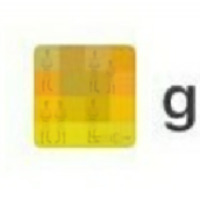
The replies also included a Rickroll, which KnowYourMeme classifies as a “bait-and-switch” meme.
You might have noticed a lot of mixed reactions in the screenshots I included. “I am tired and I will never be free”, “fuck you op” (op stands for original poster in this context), or this fantastic reaction image provided in the last one:

What feeling do these reactions represent? What emotion is being evoked?
I would argue that the answer to these questions is “stuplimity”, a term coined by Sianne Ngai in her article “Stuplimity: Shock and Boredom in Twentieth-Century Aesthetics”. As the title suggests, stuplimity is described as a mixture of shock and boredom.
The sudden excitation of “shock,” and the desensitization we associate with “boredom,” though diametrically opposed and seemingly mutually exclusive, are both responses that confront us with the limitations of our capacity for responding in general. Both affects are thus frequently invoked in responses to radical art usually dismissed as unsophisticated... (Ngai)
Not all memes are created equal. Or perhaps, though they may start out somewhat equal, through memographic practice, some rise above others. I’d argue this is the case with loss.jpg and Lucky Luciano, which have become so well-known and common on the internet as to be veritable cultural phenomenona. Memes, being abstract artefacts created out of norms, are necessarily a group effort. Norms can’t be established by an individual. Memographic practice is a communal project. The first few times we see a meme, the first few times we “get” a meme, we may be delighted. But eventually, over time, many people become tired of the meme. Bored. And yet, they cannot revoke their own knowledge of the “joke”, and each time they come across a new iteration they are both astonished that there are versions they have not yet seen and bored by the same joke being used over and over. “I am tired and I will never be free” is the common sentiment, and I would label this sentiment as “stuplime”.
...a rethinking of what it means to be aesthetically overpowered: a new way of theorizing the negatively affective relationship to stupefying objects previously designated by the older aesthetic notion of the sublime. One way of calling attention to the affinity between exhaustion and the astonishment particular to the sublime, invoking the latter while detaching it from its previous romantic affiliations, is to refer to the aesthetic experience I am talking about—one in which astonishment is paradoxically united with boredom as the stuplime... (Ngai)
But this isn’t the result of a single instance of a meme. It’s the collective effect of all memographic practice surrounding a meme𝒸𝒸 that constitutes stuplimity.
Stuplimity is thus the final destination, the final form if you will, of the meme.
-
In conclusion,
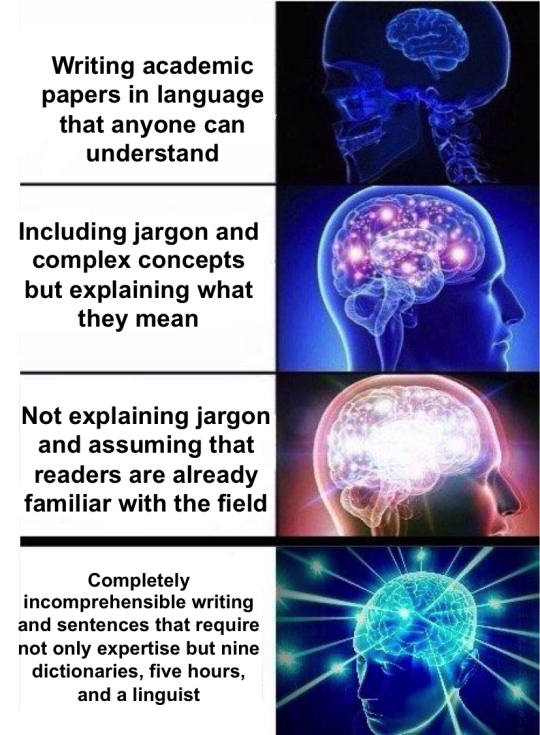
(Source x)
Get it?
-
References
I’ve collected all the Tumblr memes in a tag here (though not in any particular order) and all non-Tumblr references are collected in a works cited page here (link will only work in browser).
1 note
·
View note
Text
How to Make Memes for Your Business and Use Them Effectively
I mean, really, who doesn’t love a good meme? After all, most people use social media for entertainment. B2C marketers (business-to-customer) and business owners will do well to remember this and use their social media channels accordingly. And to that end, a good meme definitely offers fun and laughs. In fact, memes are one of the most likely forms of social media elements (along with funny videos) to go viral. And why not? They integrate and lend themselves extremely well to just about every social media platform. And the concise nature of expressive pictures associated with brief text makes them ideal for the incredibly fast-feeding frenzy that is social media today.
They are a big part of the fun on social media, and we all like to participate. Therefore, any digital marketing company worth its salt will always be asking how to generate viral memes to help engage people and drive more traffic.
So if you’re wanting a fun and creative way to engage and connect with people then maybe you should explore how to create and leverage memes for your social media marketing. And this guide will provide you with several practical tips on how to use memes more effectively.
Table of Contents:
How to Use Memes Effectively
Curate Memes for Your Keywords
Inspiration for Memes
Re-Purpose an Existing Meme
What about Copyright Infringement?
Inspirational and Motivational Memes
How to Make a Meme
Branding Your Memes
Memes Can Dramatically Improve Social Signals for Your Brand
The Key Takeaway
Why SEO Marketing is So Effective for Local Small Businesses
September 17, 2019 No Comments
If you are a small business owner or doing a startup business, or even a micro business or side-hustle, the
Read More »
Increase Post Engagement with Personal Happenings
September 25, 2017 No Comments
A sure-fire way to boost post engagement on Facebook is to occasionally post a “personal happening” – maybe once or
Read More »
Optimize SEO with Google Plus
November 21, 2017 No Comments
Optimize Your Social Media It is sometimes difficult, I know, just to keep up with posting to one’s own Facebook
Read More »
How to Use Memes Effectively
Memes should reflect the voice and tone of your business.
Let’s start with this. As a business, it’s best not to overuse memes. For some of my customers, I’ll use one per week. Others will use less, depending on the tone and voice of the business itself. Of course, you do realize that your business creates its own voice and tone, right? For example, my tendency is to try to offer insight and some humor. And that’s based upon who I am as a person and what my career has looked like. I’ve been a presenter and instructor through most of my adult life and I value humor, so I intentionally shape my social media and blogging around those traits. Some will like it, some will not. The same goes for you. Your voice and personality should resonate throughout your social channels and your blog. Anyway, on to our subject!
Your humor and your values should resonate in your memes. Some memes offer content that is inappropriate for a business–any business! Others may not be inappropriate from a social or ethical perspective, but they may not fit your business. It’s best to find those that are best suited for your voice and values.
Curate Memes for Your Keywords
I curate the vast majority of my memes. I simply run a Google search on the keyword for which I want to find a meme, then I add a qualifier like “meme”, “jokes”, or “humor”. So the search may look like this, “social media marketing memes” or “blogging jokes”. Occasionally this turns up other sources that may inspire me to create my own meme. More on that in a moment.
On some social media business accounts that I manage, I will occasionally just tell a joke that my search turns up and see if people respond. In fact, a joke told with no picture attached, often gets some of the best interactions on a page. And on Facebook, this is pure gold. So don’t be afraid to tell a joke or share a funny story, and sometimes without a picture. This may seem counterintuitive since everything in social media is so picture and video-based. And you will undoubtedly read some writers who say you should always use graphics. However, I have found that the occasional simple post with no graphics, written in a personal way, garners some of the best results on a page. Just remember to use this practice in moderation, simply because social media is image and video-centric.
Inspiration for Memes
If you have ever wondered how to make niche memes, here’s an example. As mentioned above, sometimes I find inspiration for a meme while curating or reading jokes. Just this morning, inspiration came another way. (DISCLAIMER: In the following example I am not advocating any political position on gun legislation. It is simply an instance of inspiration, so please do not take offense.) I was reading through my Facebook feed and one of my friends, a military veteran, wrote a post about guns and how he doesn’t believe guns are good or bad. When I read that, I heard in my mind for some creative and bizarre reason (since that’s what my mind is like) the words of the old song by Dave Mason, “We Just Disagree.” This is what ran through my mind: “There ain’t no good guns. There ain’t no bad guns. There’s only you and me and we just disagree.” Boom, baby! That’s meme fodder, right there. And that’s how inspiration works. So when you get, just go with it. At the end of your creative process, try to evaluate honestly whether it’s good or not-so-much.
This is an example of creating a niche meme that will get a lot of shares.
So what did I do next? What’s the process? Well, first I thought of who might best represent this sentiment in a meme? I thought of the military (like my friend). Nope. Not quite right. Perhaps someone older who would fit the age of the song reference. Yes, good idea. Maybe a gunslinger hero? Bingo. Tough guy? Definitely. Maybe a likable cowboy? Hmm…Sam Elliott? Touchdown! There have been lots of memes created with actor Sam Elliott in them. So I looked for a meme template by searching,“Sam Elliott blank memes”. I found the following pic and added the words, and I now have an original meme with a hot topic that will be very shareable.
And even though it doesn’t really fit my brand well, I will still use it just because it does have the potential to get shared. In fact, I’ve already decided how I’ll use it in a way that fits my business type. I will use it in a series of posts about creating memes that link back to this article. So you see, even though a meme may not exactly fit your brand, you can sometimes use them in a creative way and get some good social signals from it. (More about social signals later in the post…)
Re-purpose an Existing Meme
This funny pic was one that I came across in my Facebook feed. I had recently watched a video about clarity in marketing and it occurred to me that the picture in this was perfect for that theme. And as an added bonus, there was no copyright displayed, plus, there was plenty of negative space at the bottom so I was able to simply add the phrase, “Be clear in your marketing”.
This example is from a very common meme that I have seen quite a bit. However, I now have a roofer whose social media I manage, so I saw this from a different perspective. I recently wrote a blog article about soffit and fascia for him, so when I saw this meme, guess what caught my attention? Right. Browsing through all those roofing images and pictures of fascia suddenly paid off in a different way.
So you can sometimes see a meme or funny picture from a different perspective and re-purpose and reframe it to that new point of view. And it this case, the different perspective is what actually creates the humor. BTW, it’s also good to include the new keywords in the title. The title and description of this image use the words “fascia board” and “meme”.
Share it on the right social media channel, but put your own spin on it.
Another good practice is to simply share existing memes and put your own spin on it in your comments. The massively popular grumpy cat meme has offered me several such opportunities. The one that says, “Had fun once. Hated it.” has given me a lot to work with. For example, add a comment like, “Warning: This is my mode every Monday” or “every morning before coffee.” These things personalize the existing meme and add your voice to it. This is why it is a very good practice to comment on nearly anything you share, even if it’s only a simple “LOL” or “So true” comment. And if you can’t come up with a salient comment to add, just use something simple and then add an emoji or gif.
Another note of importance here is that every meme you use may not fit every social media channel. For example, what works well on Facebook sometimes won’t work nearly as well on LinkedIn due to the vast difference in those two channels. So consider the SM channel and whether the meme fits in with the ambiance.
But what about copyright infringement?
Great question! Strictly speaking, you can assume that any meme that is popular has been copyrighted. So if you don’t find it in a Creative Commons search or website, or if it isn’t public domain, then you had better realize that you don’t own the right to freely share it. But, that being said, with literally millions of memes being created and shared on a daily basis, sharing on social media is a bit of a different critter. If you stick with the most popular memes, licensed meme generating software sites, or simply sharing and commenting, the preponderance of anecdotal evidence (millions of memes created and shared daily) tells us that we really need not worry. Here is a helpful article from Northeastern University that explores the legalities and disposition in which courts view memes.
Inspirational and Motivational Memes
Brainy Quote offers a good source of intelligent inspirational and motivational quotes. This pic was from their Top Ten list. (Click the image to visit the website.)
Both of these genres can be helpful in your social media content curation and planning. Some of the businesses I work with will specifically request more motivational or inspirational posts, while others lean more toward current events or humor. I personally advocate a blend of all of these. Here are a good experiment and analysis. Simply observe your Facebook, Twitter, or Instagram feed for two or three days and take note of the memes that gain the most traction and popularity among your friends. Rule out any that come from pages that you follow, and simply observe what your friends (or followers) share. This will give you an anecdotal sampling of what is resonating with what kinds of people.
Now consider, what demographics are you targeting in your social media? If you don’t have many that fit this avatar in your personal Facebook feed, then join a group where these folks hang out. You will be able to observe them there. This can help you determine what mix or style of meme content you want to post on your social media. And remember, just because you may like your memes funny, that doesn’t necessarily mean that that is what appeals best to everyone else. Be open to using motivational or inspirational memes since they are very popular. And conversely, if you tend to gravitate toward the more serious memes, don’t be afraid to lighten it up and use some joke memes. I guarantee that some of your readers will appreciate it.
How to Make a Meme
An example of a meme to provoke conversation on social media.
Perhaps the easiest way to make your own memes is to use an online meme generator such as imgflip.com or makeameme.org. There are free versions of various sites where you can browse the images and create your text very simply. These will typically be watermarked or branded by the software. To create versions of these without watermarks, which I recommend, you can usually get a paid “pro” version of the more popular meme generators which is very inexpensive. I just paid $2.95 for one month in imageflip and made this meme. Plus, if you’re concerned about copyrights, this may be the best avenue for you.
For those who are more DIYers, rather than using an online meme maker you may prefer to use your own editing software (I highly recommend Affinity Photo) or online graphics sites like Canva.com are the usual choices.
Branding Your Memes
It’s a good practice to brand a meme that you have created so long as you intend to use it as a promotional feature. It’s akin to wearing a tee-shirt with your company name or sporting a window cling with your business name in your car. I do it on business-relevant memes or on memes that I create that I think may have a chance of going viral. Even so, I don’t brand most of the existing popular memes I use, mainly because everyone knows that’s a “rip-off” and in my humble opinion it cheapens the feel of your brand and has a bit of a greasy uber-salesman vibe to it.
When you do brand, the standard practice is to place your logo and/or name (I personally prefer the printed name version of my logo) somewhere on the meme with some transparency so it is not glaring and detracting from the overall effect. It has become more common of late to place your brand somewhere inside the image rather than at the extreme bottom. This way, it’s not as easy for others to rip-off…um, excuse me…borrow your meme and replace your logo with theirs.
Are you missing out on your social media's potential for outreach? Get professional social media management now.
Let's Get Started!
Memes can dramatically improve Social Signals for your brand.
Many people who aren’t involved with SEO tactics are unfamiliar with social signals. In short, they are all the interactions and link follows you get from social channels. These all eventually drip out to all the various search engines as signals that your brand and your website have popularity and relevance. This means that every share, like, pin, view, and vote matters. In fact, they matter a great deal.
You see, search engines interpret your social signals as legitimate evidence that your brand is being seen and shared by consumers. This, then, translates into an improvement in your website or social channel’s SERP (Search Engine Page Rank). And that’s because social signals you’re receiving are interpreted as trusted recommendations for your brand from consumers. You should not underestimate the significant importance of social signals for your brand marketing. And just think, memes, when used effectively, can help with that!
The Key Takeaway
Due to the transient and fickle nature of social mood, popular and relevant themes will ebb and flow. Still, we believe that memes are now a permanent part of social sharing. These little jewels are simple to make and even easier for people to share, so from a marketing perspective, the ROI is great considering their explosive potential of going viral.
That being said, you must still give due diligence to your keywords, meme content, your target demographic and how it integrates with your brand. But wow, when the stars align for you, your meme could expand your brand like never before!
Like this? Please share it!
Share on facebook
Share on twitter
Share on linkedin
Share on pinterest
Share on reddit
Share on email
The post How to Make Memes for Your Business and Use Them Effectively appeared first on Ozark Web Design.
from Ozark Web Design https://ozarkwebdesign.com/how-to-make-memes-for-your-business-and-use-them-effectively/
0 notes
Text
How to Make Memes for Your Business and Use Them Effectively
I mean, really, who doesn’t love a good meme? After all, most people use social media for entertainment. B2C marketers (business-to-customer) and business owners will do well to remember this and use their social media channels accordingly. And to that end, a good meme definitely offers fun and laughs. In fact, memes are one of the most likely forms of social media elements (along with funny videos) to go viral. And why not? They integrate and lend themselves extremely well to just about every social media platform. And the concise nature of expressive pictures associated with brief text makes them ideal for the incredibly fast-feeding frenzy that is social media today.
They are a big part of the fun on social media, and we all like to participate. Therefore, any digital marketing company worth its salt will always be asking how to generate viral memes to help engage people and drive more traffic.
So if you’re wanting a fun and creative way to engage and connect with people then maybe you should explore how to create and leverage memes for your social media marketing. And this guide will provide you with several practical tips on how to use memes more effectively.
Table of Contents:
How to Use Memes Effectively
Curate Memes for Your Keywords
Inspiration for Memes
Re-Purpose an Existing Meme
What about Copyright Infringement?
Inspirational and Motivational Memes
How to Make a Meme
Branding Your Memes
Memes Can Dramatically Improve Social Signals for Your Brand
The Key Takeaway
Why SEO Marketing is So Effective for Local Small Businesses
September 17, 2019 No Comments
If you are a small business owner or doing a startup business, or even a micro business or side-hustle, the
Read More »
Increase Post Engagement with Personal Happenings
September 25, 2017 No Comments
A sure-fire way to boost post engagement on Facebook is to occasionally post a “personal happening” – maybe once or
Read More »
Optimize SEO with Google Plus
November 21, 2017 No Comments
Optimize Your Social Media It is sometimes difficult, I know, just to keep up with posting to one’s own Facebook
Read More »
How to Use Memes Effectively
Memes should reflect the voice and tone of your business.
Let’s start with this. As a business, it’s best not to overuse memes. For some of my customers, I’ll use one per week. Others will use less, depending on the tone and voice of the business itself. Of course, you do realize that your business creates its own voice and tone, right? For example, my tendency is to try to offer insight and some humor. And that’s based upon who I am as a person and what my career has looked like. I’ve been a presenter and instructor through most of my adult life and I value humor, so I intentionally shape my social media and blogging around those traits. Some will like it, some will not. The same goes for you. Your voice and personality should resonate throughout your social channels and your blog. Anyway, on to our subject!
Your humor and your values should resonate in your memes. Some memes offer content that is inappropriate for a business–any business! Others may not be inappropriate from a social or ethical perspective, but they may not fit your business. It’s best to find those that are best suited for your voice and values.
Curate Memes for Your Keywords
I curate the vast majority of my memes. I simply run a Google search on the keyword for which I want to find a meme, then I add a qualifier like “meme”, “jokes”, or “humor”. So the search may look like this, “social media marketing memes” or “blogging jokes”. Occasionally this turns up other sources that may inspire me to create my own meme. More on that in a moment.
On some social media business accounts that I manage, I will occasionally just tell a joke that my search turns up and see if people respond. In fact, a joke told with no picture attached, often gets some of the best interactions on a page. And on Facebook, this is pure gold. So don’t be afraid to tell a joke or share a funny story, and sometimes without a picture. This may seem counterintuitive since everything in social media is so picture and video-based. And you will undoubtedly read some writers who say you should always use graphics. However, I have found that the occasional simple post with no graphics, written in a personal way, garners some of the best results on a page. Just remember to use this practice in moderation, simply because social media is image and video-centric.
Inspiration for Memes
If you have ever wondered how to make niche memes, here’s an example. As mentioned above, sometimes I find inspiration for a meme while curating or reading jokes. Just this morning, inspiration came another way. (DISCLAIMER: In the following example I am not advocating any political position on gun legislation. It is simply an instance of inspiration, so please do not take offense.) I was reading through my Facebook feed and one of my friends, a military veteran, wrote a post about guns and how he doesn’t believe guns are good or bad. When I read that, I heard in my mind for some creative and bizarre reason (since that’s what my mind is like) the words of the old song by Dave Mason, “We Just Disagree.” This is what ran through my mind: “There ain’t no good guns. There ain’t no bad guns. There’s only you and me and we just disagree.” Boom, baby! That’s meme fodder, right there. And that’s how inspiration works. So when you get, just go with it. At the end of your creative process, try to evaluate honestly whether it’s good or not-so-much.
This is an example of creating a niche meme that will get a lot of shares.
So what did I do next? What’s the process? Well, first I thought of who might best represent this sentiment in a meme? I thought of the military (like my friend). Nope. Not quite right. Perhaps someone older who would fit the age of the song reference. Yes, good idea. Maybe a gunslinger hero? Bingo. Tough guy? Definitely. Maybe a likable cowboy? Hmm…Sam Elliott? Touchdown! There have been lots of memes created with actor Sam Elliott in them. So I looked for a meme template by searching,“Sam Elliott blank memes”. I found the following pic and added the words, and I now have an original meme with a hot topic that will be very shareable.
And even though it doesn’t really fit my brand well, I will still use it just because it does have the potential to get shared. In fact, I’ve already decided how I’ll use it in a way that fits my business type. I will use it in a series of posts about creating memes that link back to this article. So you see, even though a meme may not exactly fit your brand, you can sometimes use them in a creative way and get some good social signals from it. (More about social signals later in the post…)
Re-purpose an Existing Meme
This funny pic was one that I came across in my Facebook feed. I had recently watched a video about clarity in marketing and it occurred to me that the picture in this was perfect for that theme. And as an added bonus, there was no copyright displayed, plus, there was plenty of negative space at the bottom so I was able to simply add the phrase, “Be clear in your marketing”.
This example is from a very common meme that I have seen quite a bit. However, I now have a roofer whose social media I manage, so I saw this from a different perspective. I recently wrote a blog article about soffit and fascia for him, so when I saw this meme, guess what caught my attention? Right. Browsing through all those roofing images and pictures of fascia suddenly paid off in a different way.
So you can sometimes see a meme or funny picture from a different perspective and re-purpose and reframe it to that new point of view. And it this case, the different perspective is what actually creates the humor. BTW, it’s also good to include the new keywords in the title. The title and description of this image use the words “fascia board” and “meme”.
Share it on the right social media channel, but put your own spin on it.
Another good practice is to simply share existing memes and put your own spin on it in your comments. The massively popular grumpy cat meme has offered me several such opportunities. The one that says, “Had fun once. Hated it.” has given me a lot to work with. For example, add a comment like, “Warning: This is my mode every Monday” or “every morning before coffee.” These things personalize the existing meme and add your voice to it. This is why it is a very good practice to comment on nearly anything you share, even if it’s only a simple “LOL” or “So true” comment. And if you can’t come up with a salient comment to add, just use something simple and then add an emoji or gif.
Another note of importance here is that every meme you use may not fit every social media channel. For example, what works well on Facebook sometimes won’t work nearly as well on LinkedIn due to the vast difference in those two channels. So consider the SM channel and whether the meme fits in with the ambiance.
But what about copyright infringement?
Great question! Strictly speaking, you can assume that any meme that is popular has been copyrighted. So if you don’t find it in a Creative Commons search or website, or if it isn’t public domain, then you had better realize that you don’t own the right to freely share it. But, that being said, with literally millions of memes being created and shared on a daily basis, sharing on social media is a bit of a different critter. If you stick with the most popular memes, licensed meme generating software sites, or simply sharing and commenting, the preponderance of anecdotal evidence (millions of memes created and shared daily) tells us that we really need not worry. Here is a helpful article from Northeastern University that explores the legalities and disposition in which courts view memes.
Inspirational and Motivational Memes
Brainy Quote offers a good source of intelligent inspirational and motivational quotes. This pic was from their Top Ten list. (Click the image to visit the website.)
Both of these genres can be helpful in your social media content curation and planning. Some of the businesses I work with will specifically request more motivational or inspirational posts, while others lean more toward current events or humor. I personally advocate a blend of all of these. Here are a good experiment and analysis. Simply observe your Facebook, Twitter, or Instagram feed for two or three days and take note of the memes that gain the most traction and popularity among your friends. Rule out any that come from pages that you follow, and simply observe what your friends (or followers) share. This will give you an anecdotal sampling of what is resonating with what kinds of people.
Now consider, what demographics are you targeting in your social media? If you don’t have many that fit this avatar in your personal Facebook feed, then join a group where these folks hang out. You will be able to observe them there. This can help you determine what mix or style of meme content you want to post on your social media. And remember, just because you may like your memes funny, that doesn’t necessarily mean that that is what appeals best to everyone else. Be open to using motivational or inspirational memes since they are very popular. And conversely, if you tend to gravitate toward the more serious memes, don’t be afraid to lighten it up and use some joke memes. I guarantee that some of your readers will appreciate it.
How to Make a Meme
An example of a meme to provoke conversation on social media.
Perhaps the easiest way to make your own memes is to use an online meme generator such as imgflip.com or makeameme.org. There are free versions of various sites where you can browse the images and create your text very simply. These will typically be watermarked or branded by the software. To create versions of these without watermarks, which I recommend, you can usually get a paid “pro” version of the more popular meme generators which is very inexpensive. I just paid $2.95 for one month in imageflip and made this meme. Plus, if you’re concerned about copyrights, this may be the best avenue for you.
For those who are more DIYers, rather than using an online meme maker you may prefer to use your own editing software (I highly recommend Affinity Photo) or online graphics sites like Canva.com are the usual choices.
Branding Your Memes
It’s a good practice to brand a meme that you have created so long as you intend to use it as a promotional feature. It’s akin to wearing a tee-shirt with your company name or sporting a window cling with your business name in your car. I do it on business-relevant memes or on memes that I create that I think may have a chance of going viral. Even so, I don’t brand most of the existing popular memes I use, mainly because everyone knows that’s a “rip-off” and in my humble opinion it cheapens the feel of your brand and has a bit of a greasy uber-salesman vibe to it.
When you do brand, the standard practice is to place your logo and/or name (I personally prefer the printed name version of my logo) somewhere on the meme with some transparency so it is not glaring and detracting from the overall effect. It has become more common of late to place your brand somewhere inside the image rather than at the extreme bottom. This way, it’s not as easy for others to rip-off…um, excuse me…borrow your meme and replace your logo with theirs.
Are you missing out on your social media's potential for outreach? Get professional social media management now.
Let's Get Started!
Memes can dramatically improve Social Signals for your brand.
Many people who aren’t involved with SEO tactics are unfamiliar with social signals. In short, they are all the interactions and link follows you get from social channels. These all eventually drip out to all the various search engines as signals that your brand and your website have popularity and relevance. This means that every share, like, pin, view, and vote matters. In fact, they matter a great deal.
You see, search engines interpret your social signals as legitimate evidence that your brand is being seen and shared by consumers. This, then, translates into an improvement in your website or social channel’s SERP (Search Engine Page Rank). And that’s because social signals you’re receiving are interpreted as trusted recommendations for your brand from consumers. You should not underestimate the significant importance of social signals for your brand marketing. And just think, memes, when used effectively, can help with that!
The Key Takeaway
Due to the transient and fickle nature of social mood, popular and relevant themes will ebb and flow. Still, we believe that memes are now a permanent part of social sharing. These little jewels are simple to make and even easier for people to share, so from a marketing perspective, the ROI is great considering their explosive potential of going viral.
That being said, you must still give due diligence to your keywords, meme content, your target demographic and how it integrates with your brand. But wow, when the stars align for you, your meme could expand your brand like never before!
Like this? Please share it!
Share on facebook
Share on twitter
Share on linkedin
Share on pinterest
Share on reddit
Share on email
The post How to Make Memes for Your Business and Use Them Effectively appeared first on Ozark Web Design.
source https://ozarkwebdesign.com/how-to-make-memes-for-your-business-and-use-them-effectively/ from Ozark Web Design https://ozarkwebdesign1.blogspot.com/2019/10/how-to-make-memes-for-your-business-and.html
0 notes
Text
How to Make Memes for Your Business and Use Them Effectively
I mean, really, who doesn’t love a good meme? After all, most people use social media for entertainment. B2C marketers (business-to-customer) and business owners will do well to remember this and use their social media channels accordingly. And to that end, a good meme definitely offers fun and laughs. In fact, memes are one of the most likely forms of social media elements (along with funny videos) to go viral. And why not? They integrate and lend themselves extremely well to just about every social media platform. And the concise nature of expressive pictures associated with brief text makes them ideal for the incredibly fast-feeding frenzy that is social media today.
They are a big part of the fun on social media, and we all like to participate. Therefore, any digital marketing company worth its salt will always be asking how to generate viral memes to help engage people and drive more traffic.
So if you’re wanting a fun and creative way to engage and connect with people then maybe you should explore how to create and leverage memes for your social media marketing. And this guide will provide you with several practical tips on how to use memes more effectively.
Table of Contents:
How to Use Memes Effectively
Curate Memes for Your Keywords
Inspiration for Memes
Re-Purpose an Existing Meme
What about Copyright Infringement?
Inspirational and Motivational Memes
How to Make a Meme
Branding Your Memes
Memes Can Dramatically Improve Social Signals for Your Brand
The Key Takeaway
Why SEO Marketing is So Effective for Local Small Businesses
September 17, 2019 No Comments
If you are a small business owner or doing a startup business, or even a micro business or side-hustle, the
Read More »
Increase Post Engagement with Personal Happenings
September 25, 2017 No Comments
A sure-fire way to boost post engagement on Facebook is to occasionally post a “personal happening” – maybe once or
Read More »
Optimize SEO with Google Plus
November 21, 2017 No Comments
Optimize Your Social Media It is sometimes difficult, I know, just to keep up with posting to one’s own Facebook
Read More »
How to Use Memes Effectively
Memes should reflect the voice and tone of your business.
Let’s start with this. As a business, it’s best not to overuse memes. For some of my customers, I’ll use one per week. Others will use less, depending on the tone and voice of the business itself. Of course, you do realize that your business creates its own voice and tone, right? For example, my tendency is to try to offer insight and some humor. And that’s based upon who I am as a person and what my career has looked like. I’ve been a presenter and instructor through most of my adult life and I value humor, so I intentionally shape my social media and blogging around those traits. Some will like it, some will not. The same goes for you. Your voice and personality should resonate throughout your social channels and your blog. Anyway, on to our subject!
Your humor and your values should resonate in your memes. Some memes offer content that is inappropriate for a business–any business! Others may not be inappropriate from a social or ethical perspective, but they may not fit your business. It’s best to find those that are best suited for your voice and values.
Curate Memes for Your Keywords
I curate the vast majority of my memes. I simply run a Google search on the keyword for which I want to find a meme, then I add a qualifier like “meme”, “jokes”, or “humor”. So the search may look like this, “social media marketing memes” or “blogging jokes”. Occasionally this turns up other sources that may inspire me to create my own meme. More on that in a moment.
On some social media business accounts that I manage, I will occasionally just tell a joke that my search turns up and see if people respond. In fact, a joke told with no picture attached, often gets some of the best interactions on a page. And on Facebook, this is pure gold. So don’t be afraid to tell a joke or share a funny story, and sometimes without a picture. This may seem counterintuitive since everything in social media is so picture and video-based. And you will undoubtedly read some writers who say you should always use graphics. However, I have found that the occasional simple post with no graphics, written in a personal way, garners some of the best results on a page. Just remember to use this practice in moderation, simply because social media is image and video-centric.
Inspiration for Memes
If you have ever wondered how to make niche memes, here’s an example. As mentioned above, sometimes I find inspiration for a meme while curating or reading jokes. Just this morning, inspiration came another way. (DISCLAIMER: In the following example I am not advocating any political position on gun legislation. It is simply an instance of inspiration, so please do not take offense.) I was reading through my Facebook feed and one of my friends, a military veteran, wrote a post about guns and how he doesn’t believe guns are good or bad. When I read that, I heard in my mind for some creative and bizarre reason (since that’s what my mind is like) the words of the old song by Dave Mason, “We Just Disagree.” This is what ran through my mind: “There ain’t no good guns. There ain’t no bad guns. There’s only you and me and we just disagree.” Boom, baby! That’s meme fodder, right there. And that’s how inspiration works. So when you get, just go with it. At the end of your creative process, try to evaluate honestly whether it’s good or not-so-much.
This is an example of creating a niche meme that will get a lot of shares.
So what did I do next? What’s the process? Well, first I thought of who might best represent this sentiment in a meme? I thought of the military (like my friend). Nope. Not quite right. Perhaps someone older who would fit the age of the song reference. Yes, good idea. Maybe a gunslinger hero? Bingo. Tough guy? Definitely. Maybe a likable cowboy? Hmm…Sam Elliott? Touchdown! There have been lots of memes created with actor Sam Elliott in them. So I looked for a meme template by searching,“Sam Elliott blank memes”. I found the following pic and added the words, and I now have an original meme with a hot topic that will be very shareable.
And even though it doesn’t really fit my brand well, I will still use it just because it does have the potential to get shared. In fact, I’ve already decided how I’ll use it in a way that fits my business type. I will use it in a series of posts about creating memes that link back to this article. So you see, even though a meme may not exactly fit your brand, you can sometimes use them in a creative way and get some good social signals from it. (More about social signals later in the post…)
Re-purpose an Existing Meme
This funny pic was one that I came across in my Facebook feed. I had recently watched a video about clarity in marketing and it occurred to me that the picture in this was perfect for that theme. And as an added bonus, there was no copyright displayed, plus, there was plenty of negative space at the bottom so I was able to simply add the phrase, “Be clear in your marketing”.
This example is from a very common meme that I have seen quite a bit. However, I now have a roofer whose social media I manage, so I saw this from a different perspective. I recently wrote a blog article about soffit and fascia for him, so when I saw this meme, guess what caught my attention? Right. Browsing through all those roofing images and pictures of fascia suddenly paid off in a different way.
So you can sometimes see a meme or funny picture from a different perspective and re-purpose and reframe it to that new point of view. And it this case, the different perspective is what actually creates the humor. BTW, it’s also good to include the new keywords in the title. The title and description of this image use the words “fascia board” and “meme”.
Share it on the right social media channel, but put your own spin on it.
Another good practice is to simply share existing memes and put your own spin on it in your comments. The massively popular grumpy cat meme has offered me several such opportunities. The one that says, “Had fun once. Hated it.” has given me a lot to work with. For example, add a comment like, “Warning: This is my mode every Monday” or “every morning before coffee.” These things personalize the existing meme and add your voice to it. This is why it is a very good practice to comment on nearly anything you share, even if it’s only a simple “LOL” or “So true” comment. And if you can’t come up with a salient comment to add, just use something simple and then add an emoji or gif.
Another note of importance here is that every meme you use may not fit every social media channel. For example, what works well on Facebook sometimes won’t work nearly as well on LinkedIn due to the vast difference in those two channels. So consider the SM channel and whether the meme fits in with the ambiance.
But what about copyright infringement?
Great question! Strictly speaking, you can assume that any meme that is popular has been copyrighted. So if you don’t find it in a Creative Commons search or website, or if it isn’t public domain, then you had better realize that you don’t own the right to freely share it. But, that being said, with literally millions of memes being created and shared on a daily basis, sharing on social media is a bit of a different critter. If you stick with the most popular memes, licensed meme generating software sites, or simply sharing and commenting, the preponderance of anecdotal evidence (millions of memes created and shared daily) tells us that we really need not worry. Here is a helpful article from Northeastern University that explores the legalities and disposition in which courts view memes.
Inspirational and Motivational Memes
Brainy Quote offers a good source of intelligent inspirational and motivational quotes. This pic was from their Top Ten list. (Click the image to visit the website.)
Both of these genres can be helpful in your social media content curation and planning. Some of the businesses I work with will specifically request more motivational or inspirational posts, while others lean more toward current events or humor. I personally advocate a blend of all of these. Here are a good experiment and analysis. Simply observe your Facebook, Twitter, or Instagram feed for two or three days and take note of the memes that gain the most traction and popularity among your friends. Rule out any that come from pages that you follow, and simply observe what your friends (or followers) share. This will give you an anecdotal sampling of what is resonating with what kinds of people.
Now consider, what demographics are you targeting in your social media? If you don’t have many that fit this avatar in your personal Facebook feed, then join a group where these folks hang out. You will be able to observe them there. This can help you determine what mix or style of meme content you want to post on your social media. And remember, just because you may like your memes funny, that doesn’t necessarily mean that that is what appeals best to everyone else. Be open to using motivational or inspirational memes since they are very popular. And conversely, if you tend to gravitate toward the more serious memes, don’t be afraid to lighten it up and use some joke memes. I guarantee that some of your readers will appreciate it.
How to Make a Meme
An example of a meme to provoke conversation on social media.
Perhaps the easiest way to make your own memes is to use an online meme generator such as imgflip.com or makeameme.org. There are free versions of various sites where you can browse the images and create your text very simply. These will typically be watermarked or branded by the software. To create versions of these without watermarks, which I recommend, you can usually get a paid “pro” version of the more popular meme generators which is very inexpensive. I just paid $2.95 for one month in imageflip and made this meme. Plus, if you’re concerned about copyrights, this may be the best avenue for you.
For those who are more DIYers, rather than using an online meme maker you may prefer to use your own editing software (I highly recommend Affinity Photo) or online graphics sites like Canva.com are the usual choices.
Branding Your Memes
It’s a good practice to brand a meme that you have created so long as you intend to use it as a promotional feature. It’s akin to wearing a tee-shirt with your company name or sporting a window cling with your business name in your car. I do it on business-relevant memes or on memes that I create that I think may have a chance of going viral. Even so, I don’t brand most of the existing popular memes I use, mainly because everyone knows that’s a “rip-off” and in my humble opinion it cheapens the feel of your brand and has a bit of a greasy uber-salesman vibe to it.
When you do brand, the standard practice is to place your logo and/or name (I personally prefer the printed name version of my logo) somewhere on the meme with some transparency so it is not glaring and detracting from the overall effect. It has become more common of late to place your brand somewhere inside the image rather than at the extreme bottom. This way, it’s not as easy for others to rip-off…um, excuse me…borrow your meme and replace your logo with theirs.
Are you missing out on your social media's potential for outreach? Get professional social media management now.
Let's Get Started!
Memes can dramatically improve Social Signals for your brand.
Many people who aren’t involved with SEO tactics are unfamiliar with social signals. In short, they are all the interactions and link follows you get from social channels. These all eventually drip out to all the various search engines as signals that your brand and your website have popularity and relevance. This means that every share, like, pin, view, and vote matters. In fact, they matter a great deal.
You see, search engines interpret your social signals as legitimate evidence that your brand is being seen and shared by consumers. This, then, translates into an improvement in your website or social channel’s SERP (Search Engine Page Rank). And that’s because social signals you’re receiving are interpreted as trusted recommendations for your brand from consumers. You should not underestimate the significant importance of social signals for your brand marketing. And just think, memes, when used effectively, can help with that!
The Key Takeaway
Due to the transient and fickle nature of social mood, popular and relevant themes will ebb and flow. Still, we believe that memes are now a permanent part of social sharing. These little jewels are simple to make and even easier for people to share, so from a marketing perspective, the ROI is great considering their explosive potential of going viral.
That being said, you must still give due diligence to your keywords, meme content, your target demographic and how it integrates with your brand. But wow, when the stars align for you, your meme could expand your brand like never before!
Like this? Please share it!
Share on facebook
Share on twitter
Share on linkedin
Share on pinterest
Share on reddit
Share on email
The post How to Make Memes for Your Business and Use Them Effectively appeared first on Ozark Web Design.
source https://ozarkwebdesign.com/how-to-make-memes-for-your-business-and-use-them-effectively/
0 notes
Text
What makes things on the Internet go viral?
Among the other factors that can help make content go viral is the social currency it provides sharers. Although the term has different meanings in various contexts, it's used in the viral content context to refer to the idea that a person will share something in order to create the impression that he or she is "in the know," or at the cutting edge of Internet infotainment [source: Konnikova].Think of social currency in this setting as akin to knowing a secret handshake or the password to get by the doorman at a New York City speakeasy. Sharing something like the latest LOLcats pic or referencing other viral content like the What Does the Fox Say video is like saying "Hey, I'm cool. I know what's going down on the interwebs," without hitting people over the head with the fact that your finger is on the pulse of viral culture [source: Konnikova].
LOLcats. For the uninitiated – those who have somehow been able to avoid what appears to be a nonstop, social media-fueled avalanche of photos of cats doing funny things accompanied by cryptic, grammatically deficient messages – LOLcat is an Internetthing. A big one. It started in 2006 with an image of a fat cat looking at a camera, with the headline "I CAN HAS CHEEZBURGER?" emblazoned across the top. Today, a family of Web sites dedicated to this and other Internet memes sees more than 20 million unique visitors each month [sources: Grossman, cheezburger.com].
That's what Web folks call viral content: Something that spreads so fast on the Internet that it dominates Facebook and Twitter news feeds and racks up page views and clicks the way Elvis Presley used to take down fried peanut butter and banana sandwiches. Often, it's a silly or ridiculous photo or video along the lines of the "cheezburger" cat, a weird Chinese goat or various groups of people doing the Harlem Shake. Sometimes, however, more meaningful pieces like the Kony2012 video depicting the hunt for African warlord Joseph Kony catch Internet fire. Dubbed the fastest growing viral video of all time, the clip garnered 100 million views in just six days [sources: Breakthrough Content, Invisible Children].
Of course, the Internet is chock full o' crazy pet pics, cute babies, strange dance crazes and socially responsible documentaries. Why do some of them get millions of views while others get a few hundred (or less)? It was all the way back in 350 B.C.E. when Aristotle came up with his theory for making speeches memorable. The Greek philosopher concluded that the talk must have an ethical, logical or emotional appeal. These days, it seems tugging on the heart strings is the way to go viral on the Web [source: Konnikova].
In order for Web content to go viral, it has to make people feel something. Positive emotions – joy, inspiration, amusement, hope – are the most powerful drivers of clicks and shares, but content that spurs anger, disgust, sadness and frustration can also become viral.
Professors Jonah Berger and Katherine Milkman, behavioral scholars at the University of Pennsylvania's Wharton business school, studied 7,000 New York Times articles in an extensive effort to understand why some of them made the paper's "most emailed" list and others did not. They found that stories including emotionalcontent were more likely to be shared among readers than those on nonemotional topics [sources: Konnikova, Jaffe].
Berger and Milkman also determined that those articles that evoked positive emotions were more likely to be shared than those evoking negative feelings. Perhaps more importantly, the pair concluded that the level of arousal of the emotions involved also played a role in something going viral. Content that drew on high-arousal feelings like anger, anxiety and awe became viral more often than those that evoked lower-arousal emotions, such as sadness. One explanation for this is that high-arousal emotions get people worked up and more likely to take some sort of action, like sharing a story, video or photo through social media, while low-arousal emotions often have a subduing result [sources: Konnikova, Jaffe].
The easiest and most effective way to convey emotions is through headlines. Former Gawker Web virality guru Neetzan Zimmerman had a knack for drawing tens of thousands of views to simple blog posts that averaged no more than 200 words a pop. How'd he do it? By piquing Web viewers interests with snappyheadlines -- Crappy Teacher Tells Kindergartner Who Pooped Her Pants To Sit On It, for instance – that grab people's attention and make them want to know more [source: Phelps].
Emotions may be key to going viral, but they're not the only thing that drives clicks and views. Never underestimate the power of human vanity.
If that doesn't work, try drawing on people's memories. One of the reasons Buzzfeed-style listicles are so darn popular is that they spatially organize information in a way that makes it easy for readers to remember later when they're in the sharing mood. There's also the added bonus that at least some of these stories are practical, making readers feel like they're providing useful information to others in their social circles [source:Konnikova].
And then there's one last major component of many viral stories. You know, the story itself. The higher the quality -- the better the story telling or more captivating the medium – the more likely readers and viewers will want to share it, according to experts like Berger and Milkman. Which, of course, is precisely the reason why you're about to share this here article on Twitter, right?
0 notes